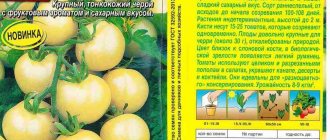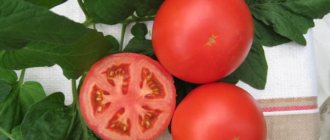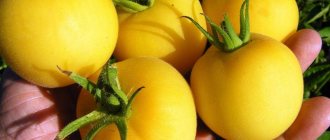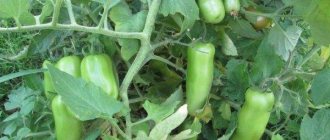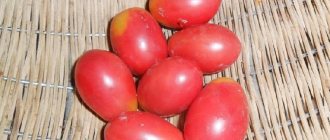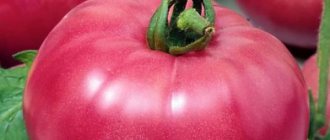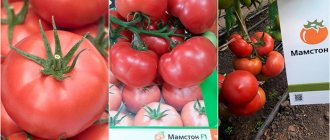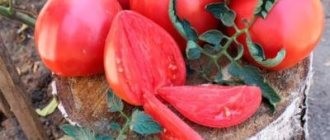The Pink Flamingo tomato can become a real puzzle for a gardener, because information about this variety is contradictory, which makes it very difficult to choose. However, all breeders and agricultural companies agree that no matter what the bushes and fruits of the next variety of cultivar look like, the harvest will be very tasty.
| Height | Landing location | Ripening time | Fruit color | Fruit size | Origin | Fruit shape |
| Medium height | Greenhouse, Open ground | Mid-early | Pink | Average | Variety | With spout |
Description and characteristics of the variety
There are many types of tomato on the market with the same name from various collectors and agricultural companies. The originator declares the tomato to be semi-determinate in height - from 1 to 1.5 m. But there are also subspecies that reach two meters, and a number of collectors offer the Pink Flamingo determinate tomato - up to 60 cm.
In terms of timing, it is classified as early rather than mid-season - 110-115 days pass from seed germination to harvest. In warm climates or in greenhouses, fruits can be harvested already on the 95th day. Usually the variety has medium-sized, 100-200 g, elongated plum-shaped tomatoes with a spout, but breeder Valentina Redko offers large, up to 800 g, heart-shaped tomatoes under this name. They are bright crimson in color with thin red stripes and have 4-6 chambers with seeds inside. The pulp is juicy, sweet and aromatic, with excellent taste.
They can be used for preservation and pickling, inclusion in various dishes and fresh consumption. Tomatoes make delicious juice and tomato pastes.
Landing
For each climatic zone, planting dates will vary, but in any region of Russia this variety should be grown in seedlings. Sowing is carried out 70 days before planting in the ground.
Growing seedlings
Planting material purchased in a store does not require preparation and is sown in pre-prepared soil. It is bought in a store or prepared from peat, sand, humus and turf soil, taken in equal proportions. Self-collected seeds must be disinfected before planting. To do this, they are placed in a pink solution of potassium permanganate for 1 hour, then the water is drained, the seeds are dried and distributed on the surface of the soil. The distance should be at least 2 by 2 cm.
Pour 1 cm of mixture on top, water generously and cover with film. With the appearance of the first shoots, the container is placed on the windowsill in the light and the covering is removed. The optimal temperature for seedlings is 18-22°C. If the weather is cloudy, additional illumination with a phytolamp is required for 3-4 hours a day.
Plants dive when they have 2 true leaves. 2 weeks after, the first fertilizing with urea is carried out. It is ideal for young plants. The working solution is prepared from 4 liters of water and 1 tablespoon of fertilizer. Feeding is repeated after two weeks.
Landing in the ground
Tomatoes are heat-loving plants, so they are planted in the ground after the threat of repeated frosts has passed. They require nutritious soil, so in the fall 20 kg of humus is added per meter, and in the spring 80 g of superphosphate and 2 g of potassium chloride are added for digging. The distance between plants should be at least 70 by 50 cm.
The procedure looks like this:
- the holes are beating;
- stakes are driven in;
- seedlings are distributed;
- abundant watering is carried out;
- the holes are filled up;
- mulching is carried out.
Features of cultivation and storage
All varieties can grow outdoors in regions where summers are warm and long enough for tomatoes to ripen. In the north, it is better to plant the Pink Flamingo tomato from Biotechnika in a greenhouse.
Medium-sized and tall bushes need pinching; it is worth leaving 2-3 main stems. They are tied to a support.
For tall bushes, pinch the top when it touches the roof of the greenhouse or when the main stem produces at least 5 clusters.
Fruits should be stored in spacious boxes so that their sides do not touch, in a cool, dry place.
Caring for mature plants
As soon as the seedlings are transplanted into permanent soil, it is time for careful care.
Even if you added fertilizers to the soil, you cannot do without additional fertilizing of the tomato bushes. During the season, 2-3 feedings with complex formulations are performed. It is important to use both organic and mineral fertilizers.
The first time you need to add food 2 weeks after planting the seedlings. At this time, organic matter is suitable - bird droppings or mullein. It is important to maintain the proportions when preparing the solution. Add 300 grams of wood ash and 50 grams of superphosphate to a bucket of the prepared solution. The composition is applied under the plants; this amount is enough to feed 20 bushes. In subsequent periods - flowering, fruit formation, tomatoes continue to be nourished with appropriate mineral supplements.
Important! Any fertilizing must be combined with watering.
For irrigation, use settled warm water. And the time for the procedure is chosen early in the morning or after sunset, so that the sun's rays do not burn the tender leaves.
Due to the fact that the description of the Pink Flamingo tomato variety indicates that the growth of the bushes is by no means small, they require shaping and gartering, as in the photo:
When growing a variety, it is important not to forget about pinching. To get a decent harvest of large tomatoes, leave no more than 4-5 bunches on the bush.
Anyone who has chosen pink tomatoes for planting should not forget that the pink Flamingo is both a demanding and grateful plant. Therefore, any care efforts will lead to good results. You can clearly see this by watching the video:
Productivity
Vegetables are used in the preparation of pizzas, salads, sandwiches, salsa, soups, juices and many other dishes. Pink flamingo has a sweetish taste, so it will harmoniously complement almost any food.
Tomatoes are even used in the preparation of cosmetic care products. For example, a mask made from tomato juice and glycerin is widely popular. It moisturizes the skin and has a healing effect against acne.
Tomato is also used in folk medicine. Even simple fresh consumption has a beneficial effect on human health.
The vegetable is capable of:
- regulate metabolic processes;
- strengthen the functioning of the kidneys and gonads;
- improve mood and cope with stress;
- regulate the activity of the gastrointestinal tract.
"Flamingo" is suitable for a wide variety of culinary uses:
- Fresh consumption;
- Cutting into salads;
- Cooking heat-treated dishes;
- Whole fruit preservation;
- Barrel salting;
- Processing into juice, paste, lecho.
“Flamingo” is characterized by a sharp transition from blanche to technical maturity against the backdrop of a rather slow overall development. On days 105-110, the gardener has the feeling that the tomatoes will no longer have time to ripen on time, but in recent days they are rapidly gaining weight and changing color from brown to signal red. From each bush you can remove up to 5 kg of marketable fruit.
READ MORE: Tomato pink giant reviews description of variety photo
IMPORTANT: If the storage conditions are observed, the collected fruits retain their commercial quality until the end of December. “Flamingo” feels best in the central regions: Bryansk, Voronezh, Moscow region
However, nominal yields can also be achieved when grown in the south in open ground or in the north in a stationary heated greenhouse.
“Flamingo” feels best in the central regions: Bryansk, Voronezh, Moscow regions. However, nominal yields can be achieved when grown in the south in open ground or in the north in a stationary heated greenhouse.
The harvest takes a long time, until October. In addition to fully ripened fruits, you can also pick slightly green ones. This variety ripens easily in a warm room. Tomatoes do not lose their quality for 2 months after harvest.
Despite the difficulties of cultivation, the resulting harvest is worth the effort. We hope our article will help you avoid problems and enjoy delicious fruits from your garden.
Appearance of the pink flamingo variety
Tomatoes of the pink flamingo variety are classified as one of three possible varieties - ordinary tomatoes. According to the accepted classification, tomato belongs to the indeterminate group according to the nature of growth and stem branching. There are noticeable hairs on the surface of the stem. The diameter of the stem is relatively small.
Due to its fragility during the formation and ripening of the fruit, the stem of the plant lies on the soil under its own weight. If we take into account numerous reviews and opinions of professional agronomists, they all recommend tying the bushes to a strong support made from pegs or specialized garters.
Upon careful examination of the leaf, you can see that it consists of several lobules or is popularly called striped. Experienced gardeners have noted an interesting observation: a healthy plant’s leaves are curled during the day, but at night, on the contrary, they are straightened. The inflorescences of the pink flamingo tomato are simple, the central axis is not branched.
The following are reviews from those who grew this variety on their plots.
“I planted the variety on my plot. After harvesting, I discovered that Pink Flamingo tomatoes have their own disadvantage: the fruits can crack. True, if you cut them into salads or put them chopped in pickling, it’s not noticeable. I advise you to carefully inspect the tomatoes before transporting them. The bushes can withstand drought, but are still picky about air temperature. Tomatoes really last quite a long time, about 2 months. Next spring I will plant this variety again.”
“I have been growing the Pink Flamingo variety for 5 years. Tomatoes require very fertile soil, so you have to select the best site. In winter I tried growing it in a heated greenhouse and reaped a pretty good harvest. There are also more worries with sowing green manure. But it is necessary to mow green manure crops very often so that their seeds cannot ripen. My kids love tomatoes because of their sweet taste. We eat them fresh and put them in jars.”
The Pink Flamingo tomato variety is quite demanding to care for. The bushes need to be fed, watered, and preventative measures taken to prevent the occurrence of diseases and pests, but, according to reviews from those who grew the variety, they really like large, sweet fruits.
Agrotechnical rules for growing tomatoes
In order not to get into trouble and get all the benefits from the variety, you need to know the recommended rules for growing and caring for the plant. It is best to start planting tomatoes in the standard way - by transplanting. In advance, it is recommended to prepare soil suitable for the varietal crop, wooden or plastic containers (piece or general), and treat purchased seeds (as a preventive measure against diseases and hardening). Sowing seeds should be done in late March - early April. Containers can be covered with plastic wrap to achieve a greenhouse effect. It is necessary to pick seedlings when 2-3 leaves appear. The temperature in the greenhouse is maintained at 25 degrees, as young, immature plants are afraid of the cold.
During the entire period of seed germination, you need to organize proper watering and not very bright lighting. Planting in the ground is carried out after 2 months from the moment of germination. The selected soil must be fertile, so before planting it is recommended to add a number of fertilizers to the soil. The distance between bushes in a row should be from 35 cm, and between rows - from 60 cm. Fertilizing with complex fertilizers, previously dissolved in warm water, should be carried out 2-3 times. The growing stem must be constantly shaped, using pegs or garters.
What did you like about the “Pink Flamingo” tomato in the first half of summer?
Pink flamingo
Tomato Pink Flamingo. Search
To increase productivity and accelerate fruit ripening, it is better to get rid of excess shoots on the plant. It is ideal to keep from 5 to 6 brushes on the bush. If yellow or brown spots appear on the leaves of the plant, experienced experts recommend adding additional mineral and organic fertilizers to the soil. Watering is best done in the evening or early morning. Tomatoes do not like cold water, so it is better to leave the water collected in the morning in iron barrels so that it warms up during the day and use it for watering in the evening. By following the specified agrotechnical rules, by mid-August you can taste the first tomatoes of the pink flamingo variety.
Pests and diseases
Although Pink Flamingo is a resistant variety of tomatoes, under unfavorable conditions the variety is affected by:
- late blight;
- mosaic of leaves;
- white rot.
When brown spots appear on the leaves at the end of summer, the bushes are sprayed with phytoncides. Treatment with a solution of Bordeaux mixture helps against late blight.
See also
Description of the Kazakhstan yellow tomato and cultivation techniques
Read
Mosaic infection is recognized by the unusual pattern of the leaf blade. Dark areas alternate with light ones. As the disease develops, it disfigures the shape of the leaves and twists them. Prevention of the disease is to soak tomato seeds in a solution of potassium permanganate.
Having discovered areas of white rot, remove damaged plants and their parts. On the stems where symptoms of the disease appear, sprinkle with lime or crushed charcoal.
Among the pests that are dangerous for tomatoes are the locust beetle and the locust beetle. The parasite larvae can destroy tomato plantings. They fight the beetle by treating the beds with insecticidal preparations.
Features of watering
The variety does not respond very well to the lack of moisture. Contrary to the general misconception that cracking of tomatoes occurs with excess moisture, tomatoes crack in the absence of it. And this disaster did not spare this variety. To balance the liquid content in the fruits and vegetative mass of the plant, regular watering is necessary.
In regions with hot summers, drip irrigation has long been practiced. It is this that can provide the optimal level of moisture with minimal consumption of water and physical activity.
"Pink Flamingo" is a decent variety. However, the search for varietal material must be approached responsibly, and if you are lucky, preserving the variety will not be difficult.
Why choose this variety?
All three pink-fruited tomatoes are popular among gardeners. They are valued for their tasty and juicy tomatoes and their productivity, although the varieties cannot be called unpretentious.
Let's list the advantages and disadvantages of the tomato variety, and start with the “pros”:
- Excellent taste.
- High commercial properties.
- Good shelf life of fruits (observing storage rules and temperature).
- The fruits are well transported (even the largest-fruited Pink Flamingo).
- Resistance to major diseases.
- If treated in a timely manner, pests are not dangerous to tomatoes.
- Possibility to grow tomatoes in beds, in greenhouses (depending on climatic conditions).
All of them show high or average yield, so by following the simplest care recommendations, every summer resident can get an excellent harvest of tomatoes.
"Minuses":
- Both determinate and indeterminate varieties require plant formation, staking, and pinching.
- The variety is demanding on temperature conditions and reacts to sudden changes.
- Does not tolerate drought particularly well, so regular watering is required.
- Varieties are susceptible to blossom end rot.
- Juices and sauces made from fruits have a good taste and excellent consistency, but in terms of color saturation they are inferior to products made from red tomatoes.
Mandatory prevention is required to prevent diseases and their consequences.
Care Tips
Whether the yield is high or low will depend on what kind of soil you have in your garden. These tomatoes love fertile soil, so you need to fertilize the soil in advance before planting the seedlings in the ground. In general, mandatory and timely feeding is necessary for bushes.
It is advisable to use warm water for watering; cold liquid may cause the root system to die.
Attention! In order not to spoil the seedlings, water the bushes only early in the morning or in the evening, while the sun has not yet risen or has already set. . Picked propagation is more suitable for this variety
The bushes should be transplanted into the garden at the end of May. It is necessary to pluck off the shoots and tie up tall bushes, otherwise you will not get the proper harvest. The tomato grows quickly, which leads to a decrease in fruiting; it is better to leave 5-6 stems and cut off the rest. By the way, for some reason weeds love these plants and constantly appear near them. We recommend that you go around the bushes in a timely manner and remove weeds, which easily get tangled in the tomatoes, taking away their vital energy.
Picked propagation is more suitable for this variety. The bushes should be transplanted into the garden at the end of May. It is necessary to pluck off the shoots and tie up tall bushes, otherwise you will not get the proper harvest. The tomato grows quickly, which leads to a decrease in fruiting; it is better to leave 5-6 stems and cut off the rest. By the way, for some reason weeds love these plants and constantly appear near them. We recommend that you go around the bushes in a timely manner and remove weeds, which easily get tangled in the tomatoes, taking away their vital energy.
In conclusion, I would like to remind you that pink flamingo tomatoes are very delicate and require careful care. Not all gardeners succeed in growing this miracle the first time, but those who do not give up and try to plant a tomato again in the new year, taking into account all the previous mistakes, reap a good harvest at the end of summer. The excellent taste of tomatoes will reward you for your efforts and wasted nerves.
